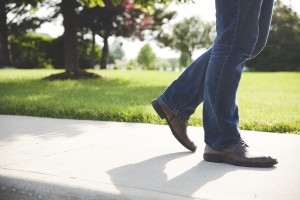 When writers come in for a massage, they rarely ask the therapist to focus on their legs. Understandably, it is the neck, back, and arms that usually feel the brunt of long hours working. But legs have some of the biggest muscles in our bodies. Most of us depend on them to get around: walking, climbing, playing sports, dancing, and supporting our upper body as we move.
When writers come in for a massage, they rarely ask the therapist to focus on their legs. Understandably, it is the neck, back, and arms that usually feel the brunt of long hours working. But legs have some of the biggest muscles in our bodies. Most of us depend on them to get around: walking, climbing, playing sports, dancing, and supporting our upper body as we move.
Unless our knees or ankles hurt, it is easy to ignore our legs. We unconsciously put them into a familiar position and then forget about them while we work. I often sit with my left knee bent and my left foot on the chair, knee up along my chest. I also frequently sit on both feet, with my knees fully bent, in a zazen position. (And I try to remember that even meditators on long retreats get up regularly for walking meditation.)
I find it impossible to sit still for any length of time with both feet flat on the floor, 6-12 inches apart. But this is the recommended “ideal” position in every guide on ergonomic computer work stations. Your knees should be relaxed and your feet should be under the knees. Knees should be just a little lower than your hips; your thighs should slope ever so slightly downwards. That’s a lot of “shoulds.”
Most ergonomic guidelines acknowledge each person is built a bit differently, and this difference should be taken into account. So I offer you some questions for when you sit for long periods.
- What is your go-to leg position when sitting at a desk? Recognizing habits is a good place to start.
- Does this position feel comfortable to your hips, knees and feet? If not, try to get comfortable and see what little adjustments you might make.
- Comfort levels are determined by how the back and neck feel, so notice them as you sit. Are there some leg positions that make you more likely to hunch your back or, alternatively, sit up straighter?
 Can you sit in the “ideal” position comfortably? If so, give it a try the next time you write at a table or desk. The moment I forget about my body and start to write, it curls up into the old familiar positions. Like I said, I’m working on it. I hope you will too.
Can you sit in the “ideal” position comfortably? If so, give it a try the next time you write at a table or desk. The moment I forget about my body and start to write, it curls up into the old familiar positions. Like I said, I’m working on it. I hope you will too.- Do you tend to cross your ankles or knees as you sit? The problem with both of these is that you will slowly compromise the circulation in your legs and feet. Blood pressure increases if your legs are crossed, and for this reason you are usually asked to keep your feet on the floor when your blood pressure is taken.
- Do you sit on one foot or keep a wallet in a back pocket? Both of these tilt the hip to one side, resulting in a twisting of the spine and neck to counterbalance the tilt.
- Do you sit with your legs straight out in front and knees somewhat locked? This can add up to a lot of stress on your front thigh muscles (“quads”), so try not to get stuck in this position for too long.
- Even the ideal position needs to be changed once in a while. Movement is needed to keep your blood circulating, your muscles supplied with fresh nutrients. Sitting too still for too long is now considered a health risk, especially when added on top of “leisure” sitting: watching TV and movies, playing video games.
- How tight are your clothes? Tight pants can restrict an important nerve near the surface that can affect sensation in the front hip and upper thigh. If there is any numbness in the area, be sure that you aren’t wearing low-rise tight jeans.
 If you can sit in a chair with your feet flat on the floor, be sure to leave a little space between your knees rather than gripping your knees together. When your feet are on the floor, shoulder width apart, your pelvis will be rolled forward, which gives your back a healthy natural arch, and you are more likely to sit up straight and be able to breath more freely.
If you can sit in a chair with your feet flat on the floor, be sure to leave a little space between your knees rather than gripping your knees together. When your feet are on the floor, shoulder width apart, your pelvis will be rolled forward, which gives your back a healthy natural arch, and you are more likely to sit up straight and be able to breath more freely.
Your leg muscles need motion and variation in length to stay in good shape. Taking a short (or long) walk during regular writing breaks is essential to your whole body.
You can also do specific leg exercises while sitting, although you’ll need to pull your chair out from under the desk:
- Raise your thigh an inch or two off the chair with your knee bent. Hold to a count of three, and let it down. Repeat on the other side.
- With your feet on the floor a foot apart, gently “flap” your knees together five times (not hard enough for them to hit each other).
- Raise your leg, with knee almost straight, and point your toes to the wall in front of you. Hold for a count of 3 and slowly lower your leg. Repeat on the other side
- Rotate your feet at your ankles, three times in each direction.
- Rock your hips back and forth, arch your back backwards and then forwards, then sit up tall and feel your spine stretch.
Recently, there has been a move to use standing desks to decrease the amount of time spent sitting still.. However, standing desks have come under recent scrutiny because people may have poor posture while standing. A static standing position may not increase muscle activity in the legs at all. But some people have found them very helpful.
 I prefer a middle path—doing a little gentle stretching before I sit, taking regular walking breaks when I work, going for a walk after I’m through writing for the day. Like now—I’m off for a walk around the block (and in unseasonably warm 60 degree weather.) If you have snow on the ground, trudging through it is even more of a workout for your legs. Remember, when you give your legs some attention, you help your entire body.
I prefer a middle path—doing a little gentle stretching before I sit, taking regular walking breaks when I work, going for a walk after I’m through writing for the day. Like now—I’m off for a walk around the block (and in unseasonably warm 60 degree weather.) If you have snow on the ground, trudging through it is even more of a workout for your legs. Remember, when you give your legs some attention, you help your entire body.

Really great to see this now as I battle sciatica. These days I write standing over the kitchen counter with “soft” knees, pelvic tilt, and weight shifting constantly from right leg to left. Thanks for the leg exercises and tips.
Sorry to hear about sciatica. Ouch. Growing wise has its aches and pains. Seems so harmless to sit with butt-in-chair since that’s what writers must do. Sitting all day turns out to be as hard on our bodies as running barefoot on concrete. Kitchen counters repurposed for creative writing instead of cuisine.